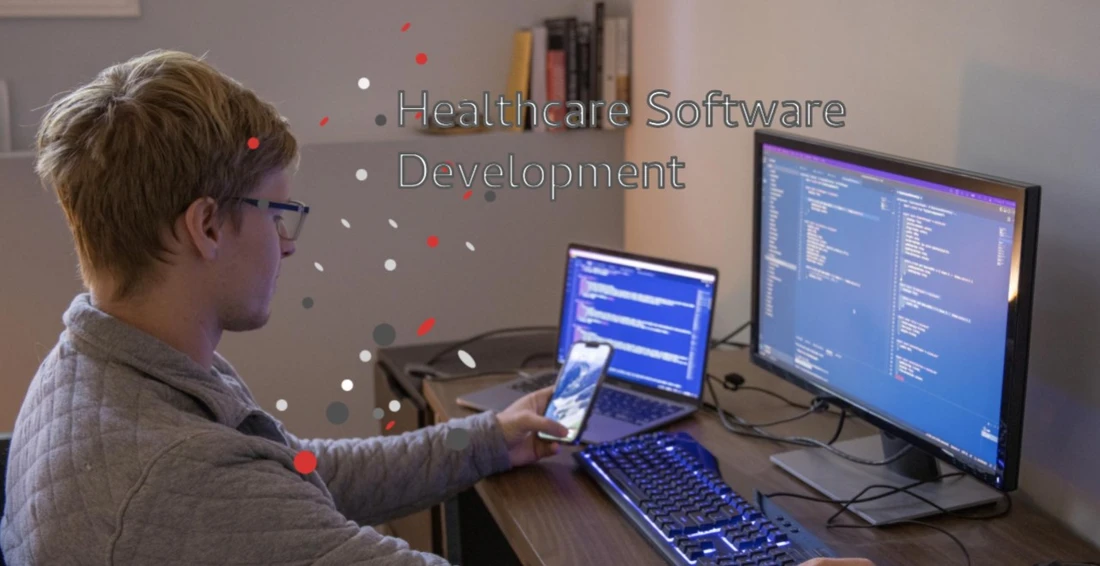The technology has revolutionized healthcare, permeating every aspect of our lives today. Telehealth, once confined to the realm of science fiction, has emerged as a vital component of contemporary healthcare. Internet technology has ushered in a new era in medicine, enabling healthcare software development that allows patients from around the world to access high-quality treatment from the comfort of their homes.
Custom healthcare software development is designed to offer remote healthcare to the patients through innovative solutions. It simplifies the distance consultations, remote monitoring of the patients, teleconferences between medical staff and VR-based treatments. In short, healthcare software development has become a medical practice that enables patients who live at a long distance to leverage healthcare systems using the electronic connection, or data transmission.
Let’s look at the core components of telehealth and how healthcare software development has redefined the sector.
Core Components of Telehealth
The core components of telehealth typically include:
- Synchronous Telehealth
Synchronous telehealth is another type of telehealth. This enables the patients and doctors to connect in real time through the video conferencing tools. It allows them to consult their doctors online, share their problems, and get advice. And do the tests by staying at home and don’t need to leave the house.
- Asynchronous Telehealth
This concept denies the prerequisite of concurrent presence through the possibility of communicating asynchronously between patients and healthcare providers. Using the telehealth platform, patients can safely email their doctors documents, photos and videos with the expectation to receive response later.
- Remote Patient Monitoring (RPM)
With the help of information technologies, this approach enables the collecting of medical data of patients in one place and then provides it to doctors in another. This abolishes the necessity of having periodic in-patient checkups as the condition is monitored constantly by tracking the symptoms, vital signs and other health indicators.
The Surge of Telehealth
Technological innovations, changing patient preferences, and, of course, the required more-efficient healthcare system have also contributed to the breathtaking jump in popularity of telehealth. COVID-19 has influenced the healthcare systems since the people resorted to self-isolation and closing down the healthcare facilities which is what accelerated the utilization of telemedicine systems. People chose virtual care over potentially dangerous in-person sessions, leading to a massive surge in the use of telehealth services during the peak of the pandemic.
Telehealth Software Development Challenges:
Beyond all the great promise for telehealth in terms of extending access to patients and improving care outcomes, there are still some distinct issues including the field of software development that should be addressed.Among these difficulties are:
- Security and Privacy Concerns: To prevent unauthorized parties from getting or attacking crucial patient information. Telehealth platforms must meet stringent privacy and security criteria. Compliance with HIPAA, strong authentication procedures as well as encryption have to be mandatory here.
- Interoperability: Many times telehealth apps need to integrate with other medical devices, EHR systems and other healthcare IT systems that already exist. The differentiation of data formats, protocols and standards can greatly affect the compatibility of different systems.
- User Experience (UX) Design: UX design should become the main thing for telehealth systems. This will ensure that the interface is usable for both the patients and healthcare practitioners. This calls for a simple yet intuitive interface, to ensure compatibility on diverse devices and screens, and to provide enough resources for customer support and training.
- Regulatory Compliance: licensure, reimbursement, and standards for telehealth practice are some of the many regulations that telemedicine has to adhere to. A key challenge for software developers could be in keeping up with the shifting regulatory frameworks besides ensuring compliance.
Opportunities in Telehealth Software Development:
Despite the challenges, the field is full of immense opportunities for software developers to be creative and drive positive change in healthcare delivery for the expanding telehealth field.
- AI and Machine Learning Integration: Telehealth approaches can be enhanced by AI and ML technologies. Such technologies include automated triage systems, individualized treatment algorithm, and predictive analytics. In order to enhance patient care, the developers can use AI algorithms to scan a vast database and discover valuable information.
- Remote Monitoring Solutions: The spread of wearable technology and wireless sensors, which connect to the Internet of Things (IoT), is occurring. Telemedicine that is able to do the remote monitoring of patients’ health parameters is in the high level of needs. For promoting preventive health care, software developers should build data platforms that communicate with these devices in real time and give the user helpful information.
- Telepsychiatry and Mental Health Services: the telehealth offers the opportunity for a decline in the mental health crisis by making these psychiatric treatments and therapy sessions accessible via telepsychiatry. In addition to that, software engineers can develop telecommunication software that includes secure video conferencing, virtual support groups, and digital psychotherapy.
- Telemedicine in Underserved Communities: These people include our rural communities, the elderly, and the immobile individuals. Developers can create telemedicine platforms preferred by these groups by using language translation, culturally tailored user interfaces, and mobile-friendly apps.
- Teleconsultation and Collaborative Care: With telehealth platforms, medical professionals can easily collaborate and exchange of information more effectively. This allows interdisciplinary care teams to better coordinate patient care and consult on complicated cases. Teleconsultation solutions that allow for encrypted chat, file sharing, and virtual case conferences can be created by developers to enhance clinical outcomes and care coordination.
Conclusion
Technology advances, patients’ shifting preferences, and the need for accessible and efficient health care solutions have led to a steep increase in telehealth and virtual care, signifying a regime shift in health care. Although telemedicine imposes certain difficulties for healthcare software development company, it also creates limitless opportunities for the development of healthcare industry and quality enhancement. Healthcare software development companies like Peerbits can improve the health and well-being of people in all parts of the world through the use of these opportunities and the solution of these problems. This will influence the further development of telehealth.




